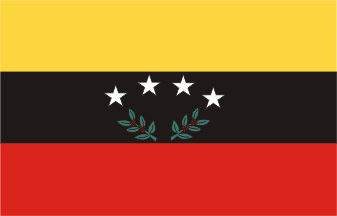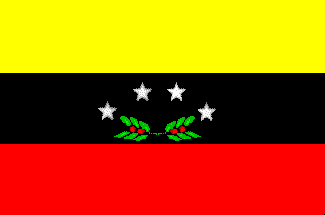
image by Jaume Ollé, 26 October 2012

Last modified: 2014-05-22 by zoltán horváth
Keywords: tachira | venezuela | coffee |
Links: FOTW homepage |
search |
disclaimer and copyright |
write us |
mirrors

image by Jaume Ollé, 26 October 2012
See also:
Municipalities (Capitals):
I located Táchira flag at
<www.funtha.gov.ve>.
Coat of Arms at <www.funtha.gov.ve/asamble>.
Sergio Horta, 6 Febuary 1999
Táchira State - Similar to the Venezuelan flag, this one has,
in the middle, a black stripe. Inside it, four stars and two
branches of coffee.
Guillermo T. Aveledo, 4 November 1999
Looking at the flag which
is shown at <www.sofitasa.com/tachira>,
one could find out that the arrangment of the stars and branches
is different from those on the image above.
There are two CoA's....one names Escudo and the other Escudo de
Armas.
Dov Gutterman, 7 December 2000
The Flag - Attributes and Meaning: The Táchira State is
located in the Andean region to the southwest of Venezuela. Its
Flag consists of three horizontal stripes: the yellow symbolizes
the "Revolución Liberal Restauradora" (Liberal
Restorer Revolution), example of the fights undertaken by the
Tachirensians on 1874 to liberate the Country from the ruling
anarchy at these times; the black recalls the historical seat of
honor of Táchira like the first State where take place the first
exploitation of Petroleum in Venezuela (Petrolia Estate, Rubio)
and the red one represents the Tachirensian blood spilled in the
Independence and the pro-democratic fights. At the center of the
flag and on the black strip appear four white stars and two
crossed branches of fruitful coffee: the stars remember the four
Cantons that gave origin to the Táchira Province on 1852
(Lobatera, San Antonio, La Grita and San Cristóbal) and its
white color is the same one that adopted like emblem the
Tachirensian Joint Holders in 1753. The coffee branches symbolize
the more important agricultural product of the State.
Historical Synthesis: The Deputy Consuelo Báez de Celis,
presiding the Commission of Legislation of the Legislative
Assembly of the Táchira State with the support of Deputies Roso
Julio Chacón and Ignacio Andrade, impel decisively the project
for bring an own flag this federal entity. By such reason, the
Academy of History of the State was convoked for the presentation
of several projects made by important Tachirensians interested in
the matter. After several meetings of work, the initial project
of Mr. Mario Díaz was approved on June 19th, 1997. After
culminated the artistic reproduction and chromatic justification,
it was enter in force the Law of Symbols and Seal of the Táchira
State, and with its the State Flag.
Source: Web Site: <www.funtha.gov.ve>.
Raul Orta, 20 December 2001
The Legislation Commission of Tachira's Legislative Assembly
decided in 1997 to adopt a representative flag for the State, as
other states had made. The presidency of the correspondent
Commission fell on Deputy Consuelo Báez de Celis, with Roso
Julio Chacón and Ignacio Andrade as the other integrants of the
commission. The Commission ad dressed the Academy of History,
which summitted several projects, as did other culturally
outstanding citizens of Tachira. The project sent by Mario Diaz
was approved on 19 June 1997, then following the corresponding
legislative procedure until the final approval of the State of
Tachira's Symbols and Seal Law of. The hoisting took place on 12
October 1997.
The flag is horizontal, yellow, black and red. Yellow symbolizes
the restorer Liberal Revolution of 1874 against President Guzman
Blanco, whose main cent er was Tachira, repressed on blood after
some months of struggle. Black represents the state's oil wealth,
Tachira being the first where this product was exploited (in La
Petrolia ranch, municipality of Rubio). Red is the blood shed by
the people of Tachir a in the independence struggle and in the
liberal revolutions. The flag contains in the black band four
white five-pointed stars, one for each of the constituent
districts of the State of Tachira in 1852 (Lobatera, San Antonio,
La Grita, San Cristobal). White is the color used by Tachira's
Comuneros in the time of the Spanish Captain General Felipe de
Ricardos. It also contains two branches of coffee, the state's
main produce.
Jaume Ollé, 13 March 2002
The flag at <www.tachira.gov.ve>
has different position of the lower stars.
Pablo Acosta Ríos, 3 October 2002

image by Guillermo T. Aveledo, 4 November 1999
s.gif)
image by Raul Orta, 20 December 2001
Coat of Arms - Attributes: The Tachirensian Coat of Arms shows
a compound shape inserted in one "Cartela" (Cartel) or
ornamental gold figure and consists of a simple field where is
represented a natural landscape with cloudy sky presided by a
river that descends from mountains towards valleys with the
figure of a maid in first plane that maintains arrogant with her
right hand the National Flag of Venezuela whilst with her left
hand pointed the waters. As ornaments appear a beam of wheat ears
jointed by a pennant enameled in gules (red), nine blue stars
with golden wakes disposed in arc and the war cry: "ESTADO
TACHIRA" like crest; a branch of cotton in flower and a
branch of coffee in its natural colors like supports at the
flanks jointed under the base with a gold pennant that loads in
gules letters the following ephemeris like mottoes: "5 de
Julio de 1811" (July 5th,1811) and 14 de Marzo de 1864
(March 14th, 1864)
Semiology : The field alludes to the exuberance of Tachirensian
valleys displayed on the Andes Mountains foot. The lady
represents Venezuela vigilant of her borders because the river
not only gives name to the Táchira state but that it is, in
addition, an international landmark. The stars represent the nine
original districts which integrated the Tachirensian territory.
The ears, the branch of cotton and the branch of coffee,
represent the fertility of the region. The pennant in gules
remembers the courage of the Tachirensian People and the golden
pennant with the ephemeris reaffirms the glory of their history
and its bond with the Venezolanity.
Historical Synthesis: Created by the Painter Don Marcos Mariño
in 1913, this CoA is effective according to establishes Article
10 of the corresponding Law.
Sources: "The Sacred Symbols of the Venezuelan Nation",
Francisco Alejandro Vargas. Caracas 1981
Web Site: <www.tachira.gov.ve>.
Raul Orta, 20 December 2001